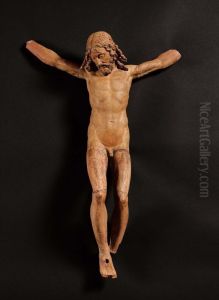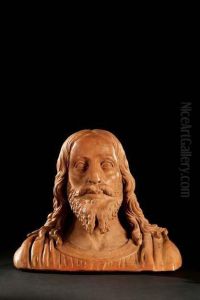Antonio Begarelli Paintings
Antonio Begarelli, also known as Antonio da Modena, was an Italian sculptor renowned for his terracotta sculptures, active during the Renaissance period. Born in 1499 in Modena, in the Emilia-Romagna region of Italy, Begarelli developed his artistic skills in a time when the Renaissance was flourishing, and various forms of art were evolving with new vigor and creativity.
Begarelli's work was primarily religious in nature, reflecting the deep spiritual and ecclesiastical roots of the period. He worked extensively with terracotta, which was a popular medium in Northern Italy due to its availability and malleability. Begarelli's sculptures are noted for their detailed execution, lifelike expressions, and dynamic compositions. He succeeded in infusing a sense of vitality and emotion into his figures, which often depicted scenes from the Bible or represented religious figures such as saints.
Despite the popularity of marble and bronze in Renaissance sculpture, Begarelli's choice of terracotta allowed him to create large-scale works that were both accessible and visually impressive. His workshop in Modena became a center of artistic production, and he trained several apprentices who carried on his techniques and style. Begarelli's influence was such that, according to Giorgio Vasari, the famous Renaissance artist Michelangelo admired his work, particularly the way Begarelli could achieve the illusion of soft flesh using the hard medium of terracotta.
Some of Begarelli's most famous works include the group of figures in the church of San Pietro in Modena and his contributions to the San Vincenzo church in the same city. His artistry extended beyond standalone figures to encompass elaborate altarpieces and complex narrative scenes. Through these works, he played a significant role in the development of sculpture in Northern Italy during the 16th century.
Antonio Begarelli continued to produce significant works of art until his death in 1565. Although he may not be as widely known as some of his contemporaries, his contribution to Renaissance art, especially in the realm of terracotta sculpture, remains influential. His legacy is preserved in the churches and museums of Italy, where his works continue to be admired for their technical skill and emotional depth.

